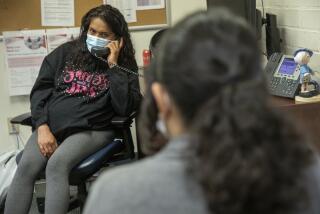Medically Uninsured Ranks in State Grow : Health: Swelling horde of unprotected includes 22% of Orange County residents under 65, study finds.
- Share via
The number of Californians without medical insurance grew from about 5.2 million to almost 6 million during a recent three-year period, and almost 90% of the uninsured are people who work for a living and their families, according to a UCLA study released Tuesday.
The report by the UCLA School of Public Health analyzes the swelling ranks of medically uninsured Californians at a time of mounting public concern about the problem but little legislative momentum toward a solution. Based on 1990 Census reports, the UCLA study concludes that 22.5% of the state’s residents under 65 are medically uninsured--compared to 16.5% nationally.
The report says that 22% of Orange County residents under age 65 have no health insurance--305,605 people. Though it did not offer detailed breakdowns by county, the study’s principal author, E. Richard Brown, said that Orange County ranks second among California counties for residents under age 65 who lack health insurance and fifth among the 30 largest metropolitan areas in the United States for non-elderly residents without health insurance.
Almost half the uninsured, or 2.7 million people, live in Los Angeles County, which has the highest percentage of medically uninsured people of any major metropolitan area in the nation. The percentage jumped from 26.7% in 1986 to 33% in 1989.
About 65% of the medically uninsured in the state are full-time jobholders and their families; another 22% are self-employed or part-time workers and their families.
Children make up nearly one-third of the uninsured. Adults 18 to 29 account for 36%.
Of all ethnic groups, Latinos are most likely to be uninsured. Researchers stated that “a shocking 42%” of the non-elderly Latino population lacks health coverage--mainly because they are employed in small businesses and in fields that typically do not provide health insurance to employees.
“The root of the problem,” said UCLA professor E. Richard Brown, “is the structure of our state economy, which directs many workers into low-wage jobs in small, often marginal firms with no health care benefits.”
The health-care needs of Americans 65 and over are covered by the federal Medicare program, and many poor people are covered by the Medicaid program, known as Medi-Cal in California.
But the vast majority of Americans traditionally have obtained health insurance through their workplace, as a fringe benefit of employment.
The UCLA report makes it clear that the private, employment-based health insurance system is riddled with holes.
The report found that workers in California are more likely than those in other states to be employed in industries such as agriculture, forestry, retail sales and entertainment services, where medical insurance is relatively uncommon.
Also, Californians are more likely to work in small businesses that typically do not provide medical insurance. Almost half of all uninsured employees work in firms with fewer than 25 workers, the report found.
“This report shows clearly and in detail the inextricable connection of the problem of the uninsured to the structure of employment and economy in California,” said Brown, an author of the report.
A flurry of bills that would attempt to broaden health-care coverage are pending in the state Legislature. Among them are measures that would require employers to provide health insurance for their employees. But the UCLA report cautions that major government subsidies would be necessary to cushion the financial impact on businesses and employees threatened by “economic dislocation, some increase in unemployment and a reduced standard of living.”
Assemblyman Burt Margolin (D--Los Angeles), chairman of the Insurance Committee and a longtime advocate of health insurance reform, called the researchers’ findings “very disturbing” and said they give new urgency to the need for legislative action.
Studies have shown that people without health insurance have less access to care. They are less likely to see a physician during a 12-month period, and they are only half as likely to seek medical care within 30 days of developing serious symptoms, such as persistent high fever, nausea or bleeding. They are also less likely to get important preventive health care--immunizations for their young children, or prenatal care during pregnancy.
When the uninsured need urgent medical care they often go to hospital emergency rooms, which are required by law to treat them. Providing “uncompensated care” to these individuals cost California hospitals $975 million during fiscal 1985-86, according to the UCLA report. Of that total, $468 million was for uncompensated care at public hospitals, a debt charged directly to taxpayers.
UCLA’s Brown said he used the 1985-86 data because he thought it was the most reliable for purposes of the study. The California Assn. of Hospitals and Health Systems, an industry group, estimates that in 1990, the cost of uncompensated care to the state’s public and private hospitals totaled $1.3 billion.
More to Read
Sign up for Essential California
The most important California stories and recommendations in your inbox every morning.
You may occasionally receive promotional content from the Los Angeles Times.










